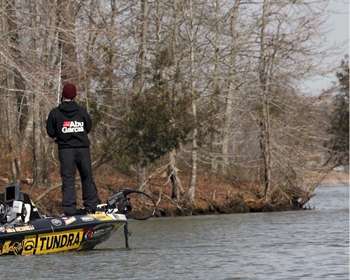
During the first few outings of the year, many bass anglers are drawn to productive looking areas like sharp points, visible cover and obvious spawning areas. In the rush to catch early season bass, many anglers make the mistake of overlooking less attractive but equally productive areas like secondary points.
As Elite Series pro Mike Iaconelli explains, there are times when secondary points should be your first option.
"Secondary points are extremely important to the life cycle of a bass," he explains. "Early in the year, they really come into play when the fish are staging during the prespawn period."
Iaconelli points out that it is important to define exactly what constitutes a secondary point. "I think that the biggest misconception about the term 'secondary point' is that it is a visible point," he explains. "It can be a physical point of land but a secondary point is much more. It can be an underwater point that you can't see with your eyes, a rockpile between spawning grounds and deep water, a lone tree or a dock that sticks out farther than other docks."
Iaconelli defines a secondary point as anything that serves as stopping grounds between a shallow water area and a deep water area.
The New Jersey pro believes that secondary points are often overlooked because there is a general misconception about how bass transition from deep water to spawning areas. "Too many people believe that when the spawn is coming, a school of bass just decides to migrate to the back of a cove. It doesn't happen like that," he opines. "Bass travel along breaklines and use contours like highways. Any change in the break or contour creates a secondary point."
Secondary points played an important role for Iaconelli during the 2009 Elite Series stop on Lake Guntersville, where he weighed in over 101 pounds of bass en route to a fourth place finish.
"Guntersville was classic secondary point fishing," he remembers. "The bass were finished spawning, but they weren't on the main lake ledges yet. I targeted areas halfway between the channel markers and the backs of pockets. I would feel a smooth bottom and when I hit a rough patch of shell, it was an automatic bite."
While targeting secondary points was key to his success, finding the "sweet spot" on the secondary points allowed him to maximize his efforts. "On any lake, there are many different secondary points," he says. "One of them will have a sweet spot, and that's what you need to focus on."
When you're looking for an early season bite in spring, take some advice from Iaconelli and spend time fishing secondary points. They may not be the most visually attractive areas or the most obvious, but there's a good chance that egg laden bass are using them as a resting spot. As Iaconelli stresses, "It's a pattern that I make sure to never overlook."




